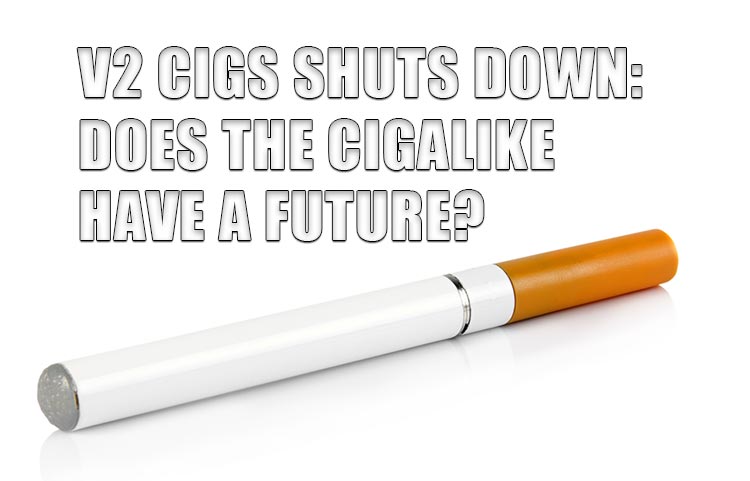Table of Contents
In October 2018, JUUL Labs announced that it was acquiring VMR products– maker of V2 Cigs – for $75 million. Although V2 Cigs was America’s leading online seller of cigalikes, V2’s sales paled in comparison to JUUL’s 75-percent share of the traditional brick-and-mortar e-cigarette market. V2 found themselves at an evolutionary dead end with their core cigalike product, and thanks to FDA regulations, the company was unable to release anything newer and more competitive. It was probably the right time for V2 to exit the market, and we’re most likely going to see the same thing happen with other cigalike brands in 2019 – either by way of acquisitions or outright closings.

The closing of V2 Cigs leads to one big question: Does the cigalike have a future? It’s certain that there are many existing cigalike users, and the people who are still using cigalikes today aren’t likely to stop. In an industry in which “JUUL” has become a verb synonymous with “to vape” in certain segments of the market, though, does the cigalike still have a place in the bigger picture? That’s what we’re going to discuss in this article.
The Cigalike’s Place in Vaping History
Today, there are probably very few smokers remaining in the developed world who aren’t aware that vaping exists. There was a time, though, when that wasn’t yet the case. During the early years of vaping, the shape of the cigalike was actually a major part of the sales pitch.
Suppose that you had no idea what vaping was, and you saw a device like the JUUL or another pod mod at your local convenience store. Would you conclude that it was something capable of replacing the pack of cigarettes that you were about to buy, or would you dismiss it as a USB stick or some other gadget in which you had no interest?
Everyone recognizes the shape of a cigarette. Any smoker who sees a cigalike will immediately know it’s a device that has something to do with smoking. During the early years of the vaping industry, the physical design of the cigalike was crucial in introducing the idea of vaping to smokers. Today, though, the cigalike is no longer necessary for that purpose. Smokers now know that vaping exists. The decision to try it is up to them.
The Problem With the Cigalike in Today’s Market
While the cigalike served an important purpose for smokers in the early years of the vaping industry, it was equally important for the companies that got in early. The potential profit margins in those days were incredible; companies could buy packaged, ready-to-use e-cigarette kits from factories in China and sell them at up to 10 times the wholesale price. The Chinese factories were so good at cheap mass production that there was no way for American, British and European e-cigarette brands to do better domestically – and why even try when the profit margins were so good? Most western e-cigarette brands never even bothered to invest in their own machines for filling cartomizers. For that reason, most cigalikes still use Chinese-made e-liquids.
Have you been vaping long enough to remember what e-liquids tasted like back in 2010-13? Would you want to go back to that experience? No, you wouldn’t – and flavor is arguably the most important aspect of vaping. In the United States, cigalikes are at a dead end when it comes to e-liquid. Companies that aren’t already using domestic e-liquids in their cartridges can’t do so because FDA regulations prevent it. Even if they can find a way to offer better-tasting cartridges without running afoul of the FDA, regulations still prevent introducing new hardware – so they’ll still find it impossible to compete with the industry titan that JUUL has become.
What Does the Future Hold for Cigalikes?
The Cigalike is Dead in the United States
In the United States, the market for cigalikes is unlikely to expand past its current point. When V2 Cigs folded, other companies scrambled to adopt V2’s orphaned customers. A few of those companies were richly rewarded for their efforts. In the long run, though, the total cigalike customer base will only shrink. The market will get smaller as users move on to other types of vaping devices, but few people will become new cigalike users. American brands that primarily sell cigalikes: You’re on notice. Evolve now. Unless your goal is to become theleading supplier in an increasingly small niche, your days are numbered.
An Uncertain Future in the United Kingdom and Europe
In the United Kingdom and Europe, the future of the cigalike isn’t nearly so clear cut. OK Vapein the United Kingdom, for example, reports that cigalikes remain an important part of their business strategy. Pod-based vaping systems, however, are increasing in popularity.
Why have cigalikes remained viable outside the United States when they’re fast approaching obsolescence here? The European Tobacco Products Directive might be the biggest reason. In the United States, one of the biggest reasons for the popularity of the JUUL e-cigarette is the extremely high nicotine strength – 59 mg – of its e-liquid. In nations bound by the TPD, though, the highest legal e-liquid nicotine strength is 20 mg. There is virtually no difference between standard e-liquids and nicotine salt e-liquids, so the sales pitch for pod-based vaping systems isn’t nearly as strong as it is in the United States.
Another key difference between the United States and other major vaping markets is that companies outside the U.S. are free to continue innovating and releasing new products. Will a company in the U.K. or Europe decide that it would be a worthwhile investment to develop and manufacture a next-generation cigalike? Unlike in the U.S., that’s not outside the realm of possibility. It seems more likely that vaping companies around the world will continue to gravitate toward selling Chinese-made devices under their original Chinese brand names, but only time can tell. If you don’t see a next-generation cigalike emerge outside the U.S. in 2019, though, it probably won’t happen at all.





